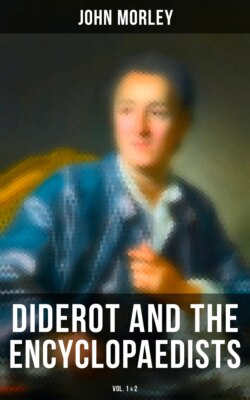Читать книгу Diderot and the Encyclopaedists (Vol. 1&2) - John Morley - Страница 11
На сайте Литреса книга снята с продажи.
II.
ОглавлениеTable of Contents
It is proper in this place to mention a short philosophic piece which Diderot wrote in 1751, his Letter on the Deaf and Dumb for the Use of those who Hear and Talk. This is not, like the Letter on the Blind, the examination of a case of the Intellect deprived of one or more of the senses. It is substantially a fragment, and a very important fragment, on Æsthetics, and as such there will be something to say about it in another chapter. But there are, perhaps, one or two points at which the Letter on the Deaf and Dumb touches the line of thought of the Letter on the Blind.
The Letter opens on the question of the origin and limits of inversion in language. This at once leads to a discussion of the natural order of ideas and expressions, and that original order, says Diderot, we can only ascertain by a study of the language of gesture. Such a study can be pursued either in assiduous conversation with one who has been deaf and dumb from birth, or by the experiment of a muet de convention, a man who foregoes the use of articulate sounds for the sake of experiment as to the process of the formation of language. Generalising this idea, Diderot proceeds to consider man as distributed into as many distinct and separate beings as he has senses. "My idea would be to decompose a man, so to speak, and to examine what he derives from each of the senses with which he is endowed. I have sometimes amused myself with this kind of metaphysical anatomy; and I found that of all the senses, the eye was the most superficial; the ear, the proudest; smell, the most voluptuous; taste, the most superstitious and the most inconstant; touch, the profoundest and the most of a philosopher. It would be amusing to get together a society, each member of which should have no more than one sense; there can be no doubt that they would all treat one another as out of their wits."
This is interesting, because it was said at the time to be the source of one of the most famous fancies in the philosophical literature of the century, the Statue in Condillac's Treatise on the Sensations. Condillac imagined a statue organised like a man, but each sense unfolding itself singly, at the will of an eternal arbiter. The philosopher first admits the exercise of smell to his Frankenstein, and enumerates the mental faculties which might be expected to be set in operation under the changing impressions made upon that one sense. The other senses are imparted to it in turn, one by one, each adding a new group of ideas to the previous stock, until at length the mental equipment is complete.
We may see the extent of the resemblance between Condillac's Statue and Diderot's muet de convention, but Diderot at least is free from the charge of borrowing. Condillac's book was published three years (1754) after the Letter on the Deaf and Dumb, and he afterwards wrote a pamphlet defending himself from the charge of having taken the fancy of his Statue from Diderot; nor, for that matter, did Diderot ever make sign or claim in the matter. We have already spoken of the relations between the two philosophers, and though it is a mistake to describe Diderot as one of Condillac's most celebrated pupils,[77] yet there is just as little reason to invert the connection, or to doubt Condillac's own assertion that the Statue was suggested to him by Mademoiselle Ferrand, that remarkable woman to whose stimulating and directing influence he always professed such deep obligation. Attention has been called to the fact that in 1671 a Parisian bookseller published a Latin version of a much more intelligent and scientific fancy than the Statue—the Philosophus Autodidactus of the Arabian, Ibn Tophail. This was a romance, in which a human being is suckled by a gazelle on a desert island in the tropics, and grows up in the manner of some Robinson Crusoe with a turn for psychological speculation, and gradually becomes conscious, through observation, of the peculiar properties belonging to his senses.[78]
Of the part of the Letter that concerns gesture, one can only say that it appears astonishingly crude to those who know the progress that has been made since Diderot's time in collecting and generalising the curious groups of fact connected with gesture-language. We can imagine the eager interest that Diderot would have had in such curious observations as that gesture-language has something like a definite syntax; that it furnishes no means of distinguishing causation from sequence or simultaneity; that savages can understand and be understood with ease and certainty in a deaf-and-dumb school.[79] Diderot was acute enough to see that the questions of language could only be solved, not by the old metaphysical methods, but experientially. For the experiential method in this matter the time was not ripe. It was no wonder, then, that after a few pages, he broke away and hastened to æsthetics.
